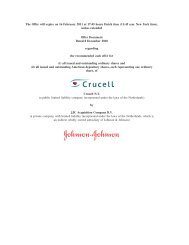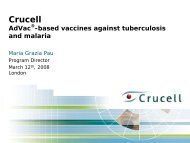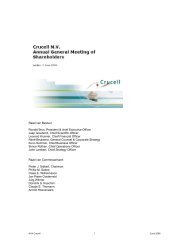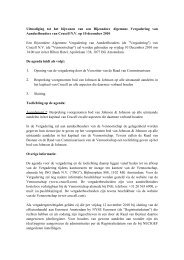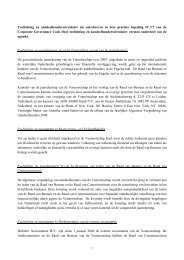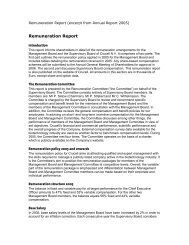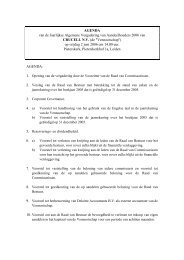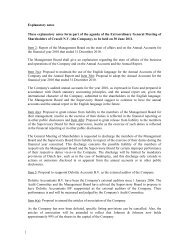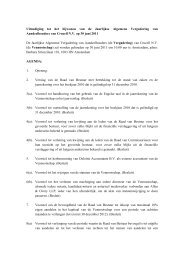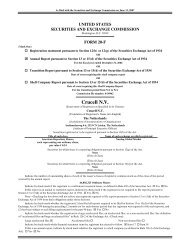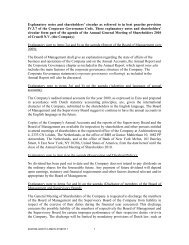Crucell corporate brochure (PDF)
Crucell corporate brochure (PDF)
Crucell corporate brochure (PDF)
Create successful ePaper yourself
Turn your PDF publications into a flip-book with our unique Google optimized e-Paper software.
56<br />
<strong>Crucell</strong>’s commitment to the world – Taking responsibility<br />
Safety improvement: a case study<br />
In January 2011, a <strong>Crucell</strong> technician had a serious accident while<br />
handling glassware in one of our production facilities. The worker<br />
was pushing a tray of bottles sprayed with antiseptic under the<br />
laminar flow hood (air-control barrier) of a sterile handling unit.<br />
The bottles toppled and fell, and the technician suffered a deep<br />
cut as he tried and failed to catch them in his gloved hands.<br />
His colleagues had received safety training and responded<br />
appropriately, most probably saving his life.<br />
If we examine the risk factors in this situation—the wet and<br />
slippery glassware, the laminar hood, the sterile gloves, the tray<br />
and handling method—we see that they are all related to Good<br />
Manufacturing Practice (GMP) in our industry. Biopharmaceutical<br />
production must be conducted under highly sterile and controlled<br />
conditions in order to ensure the safety of the people who receive<br />
our products. However, this can potentially create unsafe<br />
conditions for production workers. The challenge we face is<br />
to safeguard both our employees and products.<br />
Our safety and process experts meet this sort of challenge by<br />
analyzing the precise circumstances in which accidents occur and<br />
looking for GMP-compliant technical workarounds, or ways to<br />
avoid unsafe process steps altogether. At the same time, they focus<br />
on raising employees’ awareness of workplace risks and how to<br />
respond if an accident does occur.<br />
1 The OSHA defines the LTC as the number of accidents resulting in at least one whole<br />
shift absence, per hours worked by 100 employees in 12 months (200,000 hours).<br />
www.crucell.com<br />
One of the tasks of safety officers is to collect data on accidents,<br />
with the aim of gaining a better understanding of risk factors and how<br />
to manage them. In our 2009 CSR report, we published accident data<br />
collected independently at our five manufacturing and/or development<br />
sites (covering 90% of the workforce) but noted the limitations of these<br />
data. For example, countries used different definitions and ways<br />
of measuring accidents.<br />
In 2010, we focused on taking EHS information management to the next<br />
level by introducing a global reporting system based on harmonized<br />
criteria. Access to more detailed information, collected from our production<br />
and R&D facilities using the same definitions, will give us greater power<br />
to continuously improve safety, using a ‘plan-do-check-act’ approach.<br />
We are well on track towards this goal. A clear procedure for accident<br />
reporting, analysis and follow-up with corrective action has been<br />
introduced. An EHS Reporting Manual has been developed, local<br />
safety officers have been trained in its use and full-year data based<br />
on consistent criteria have been collected and analyzed. A reporting<br />
infrastructure has been established and is working well: local data<br />
are reported to the global EHS manager, who gives regular updates<br />
to the Chief Operating Officer (safety data on a monthly basis,<br />
other information quarterly).<br />
Accident reporting<br />
Agreeing on a consistent definition of reportable accidents was a<br />
challenge. After considerable debate, we have decided to adopt the<br />
United States’ Occupational Safety and Health Administration (OSHA)<br />
definition of lost time case rate (LTC) 1 , excluding accidents that occur<br />
on the way to or from work and excluding medical conditions (such<br />
as fainting at work). Using consistent definitions allow trends to<br />
be followed.<br />
Analysis of the LTC among <strong>Crucell</strong> employees at our five main sites over<br />
the period 2009–2010 (see graph) suggests that accident frequency has



